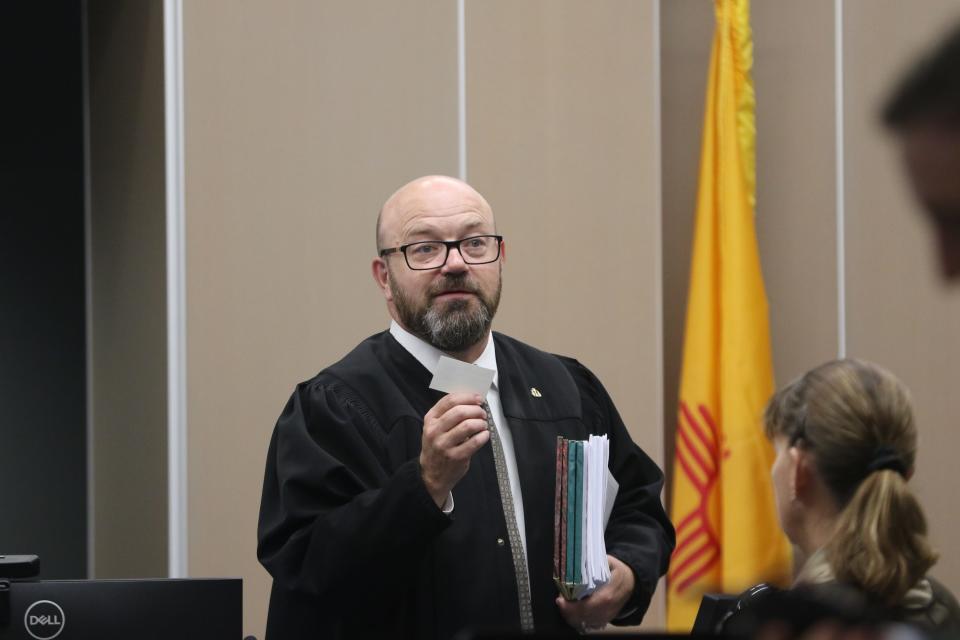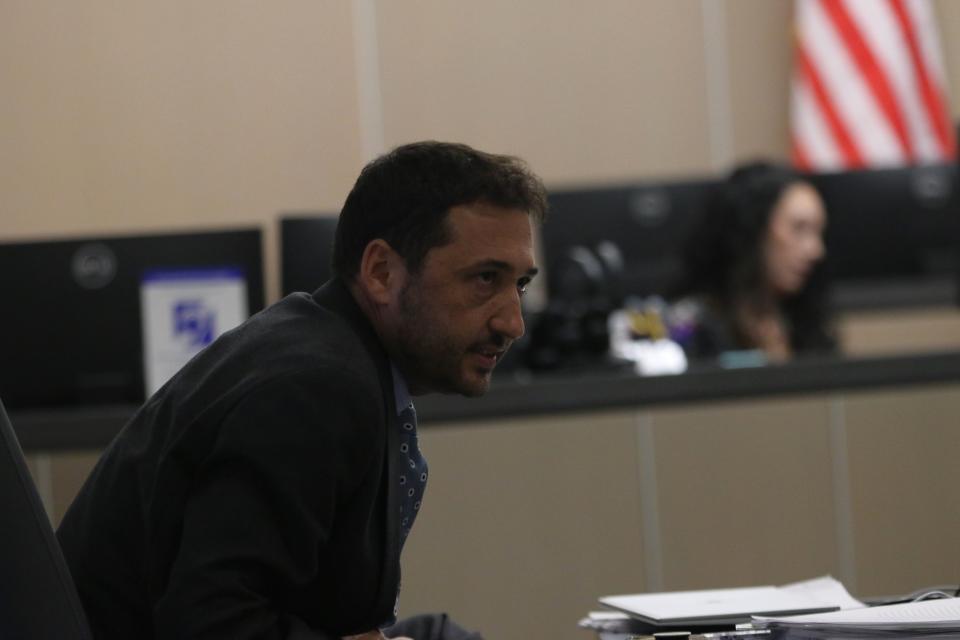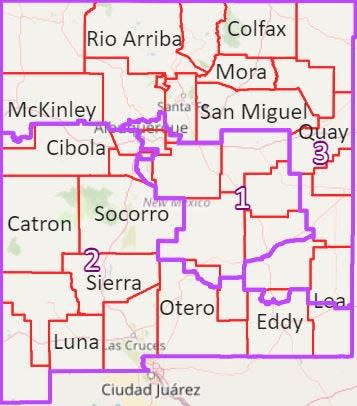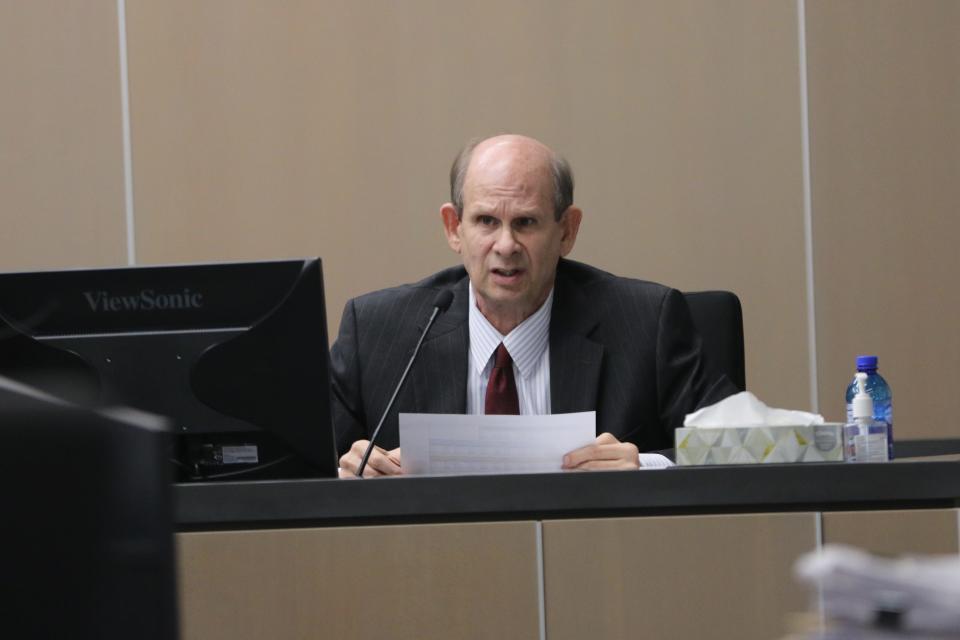New Mexico gerrymandering trial concludes, judge has a week to rule on congressional maps
- Oops!Something went wrong.Please try again later.
A southeast New Mexico district judge has a week to decide if the state’s redrawn congressional districts were unconstitutional.
A two-day trial was held amid outcry from the Republican Party that the redistricting weakened its influence.
The districts were redrawn by the New Mexico Legislature, controlled by Democrats, in response to population changes in the 2020 Census, but Republicans alleged they were largely blocked out of the process.
That’s why they sued Democrat leadership, hoping to get a ruling against the maps.
The bench trial was held in Lea County District Court in Lovington before Ninth Judicial District Judge Fred Van Soelen, and concluded Thursday. Van Soelen was appointed to the case after all the judges in the Fifth Judicial District where the case was brought, covering Eddy and Lea counties, were either recused or unavailable.
More: GOP, Democrats clash over election data in final day of New Mexico gerrymandering trial
Van Soelen was given an Oct. 6 deadline to render his verdict following the trial’s conclusion Thursday. He was awaiting additional evidence – mostly emails and text messages from lawmakers – provided by the defense.

The verdict could significantly impact New Mexico’s southern Second Congressional District, where Democrat Gabe Vasquez defeated incumbent Republican Yvette Herrell for the seat in what was viewed as a Republican stronghold before the redistricting was completed the year before.
The new map altered the district to include an urban area south of Albuquerque and moved out portions of Eddy and Lea counties.
More: GOP says Democrats diluted oilfield votes in first day of New Mexico gerrymandering trial
If Van Soelen finds the redraw was illegal, it could be vacated – either meaning the districts would be redrawn again by the judge or reverted to the previous map.
More: New Mexico gerrymandering trial starts this week. Here's what to know about the case.
Here’s how the gerrymandering trial wrapped up.
Closing arguments debate impacts of redrawing New Mexico’s maps
Oil and gas interests were at the center of the trial’s final moments, as plaintiff attorney Misha Tseytlin said Democrats purposefully diluted the impact of the oil and gas industry, and thus the deep-red southeast corner of the state where it is centered.
He argued Democrats failed to prove they properly redrew congressional district lines in 2021, and that the evidence showed Democrat state leaders engaged in an “egregious” partisan gerrymandering effort to give their party an unfair advantage.
This was largely achieved, he said, by “cracking the oilfield,” as the map passed by lawmakers in Senate Bill 1 in December 2021 broke up swaths of the southeast Permian Basin region by dividing portions of Eddy and Lea counties into different districts.

More: 'Gerrymandering' lawsuit against New Mexico Democrats delayed ahead of trial
The north half of Lea County was moved from the Second Congressional District to the Third, along with a northern section of Eddy County containing Artesia.
This spread-out oilfield interests, which are largely tied to conservative politics, Tseytlin said.
“There is no grounding in New Mexico history. No grounding in New Mexico law. It wasn’t asked for by the industry,” he said. “It was only asked for obliquely by those accused of gerrymandering. It was meant to crack southeast New Mexico, which is just what a gerrymanderer would do.”
More: New Mexico GOP's 'gerrymandering' case will proceed after Democrat arguments rejected
He pointed to the testimony of Jowei Chen, a political science professor at the University of Michigan who conducted a series of map simulations for the defense, which Chen alleged showed the new map was not “extreme” or a “political outlier.”
Chen’s simulations were given a condition that no district have more than 60% of New Mexico’s oil wells, although it was unclear if that factor was added in the SB 1 map.
Chen did testify he was told splitting up the oil wells was a “policy consideration” by the defense.
More: Gabe Vasquez wins race for New Mexico's 2nd congressional district
It showed, Tseytlin said, that the redistricting process was designed to shift the vote balance in favor of Democrats, an act he said the defendants failed during the trial to prove did not happen.
Text messages from lawmakers to staff, Tseytlin said, would show this was an intentional plan.
“They scooped Democrats into that district and scooped Republicans out,” he said. “This (the map) is an extreme outlier.”
More: Redistricting complete in New Mexico after Gov. Lujan Grisham approves senate map changes
Defense says New Mexico’s Second District still competitive after redistricting
Attorney for the defense Sara Sanchez pointed to a requirement in the case that the plaintiffs prove the alleged gerrymandering did indeed dilute Republican votes.
She argued the 2022 election, where Vasquez defeated Herrell by a narrow, 1,300-vote margin, displayed that the shifted maps did not swing the Second District (CD2) unconstitutionally toward Democrats.
Sanchez contended splitting the oil and gas industry was an issued heavily debated during the legislative process that resulted in the new map.

More: City of Carlsbad and Eddy County raise concerns over redistricting maps
“Under this plan, CD2 is a highly competitive toss up district that either party can win,” Sanchez said. “A competitive district that either party can win is not entrenchment of either political party. In fact, it is the opposite.”
She pointed to problems with Republican voter turnout expressed by Sen. David Gallegos (R-41) of Eunice, listed as a plaintiff in the case, when he took the stand Wednesday.
“Clearly, this is a highly unpopular map in certain parts of the state,” Sanchez said, alluding to opposition from the southeast region. “The reality is the GOP is in the political minority in the legislature.”
Political analyst who worked on redistricting says southern New Mexico a ‘toss-up’
Brian Sanderoff, president of Research and Polling Inc., a consultant used by the legislature to process the maps, took the stand for the defense ahead of closing arguments, and described the competitive nature of the Second District for decades.
He contended Herrell could take the seat back in 2024, now that Vasquez has developed a political record during his first term in Congress.

After the new map was instituted, Sanderoff said based on past elections and without considering other factors like name recognition or scandals, the average Democrat candidate would likely get 53% of the vote, while the GOP would get 47%.
He said this was well within the range of a competitive election, and that the new map “does not entrench the Democratic Party in New Mexico.”
“Any party can win,” Sanderoff said.
In a report Sanderoff provided on the redistricting, he said he studied the Second District’s elections dating back to 2002, when long-time Republican Congressman Steve Pearce first won the seat.
Pearce held the seat until 2008 when he ran for the U.S. Senate in a losing bid.
That year, Democrat Harry Teague won the Second District against Republican Edward Tinsley.
Pearce then ran and won the seat back from Teague in 2010 and held it until 2018 when he ran for governor.
That year, Democrat Xochitl Torres Small defeated Herrell for the seat, then lost it back to Herrell in 2020.
This pattern, Sanderoff said, showed that the Second District was a “strong, Republican-leaning” district, but never a “safe guarantee,” and testified Herrell might already have an edge going into 2024 based on recent polling.
“People who control very safe districts can be very strong-willed in their viewpoints and inflexible,” Sanderoff said. “I think competition is good.”
Adrian Hedden can be reached at 575-628-5516, achedden@currentargus.com or @AdrianHedden on X, formerly known as Twitter.
This article originally appeared on Carlsbad Current-Argus: New Mexico gerrymandering trial concludes, judge has a week to rule

